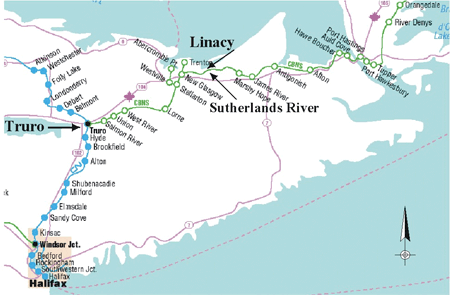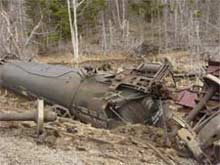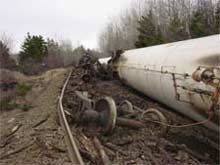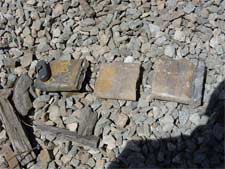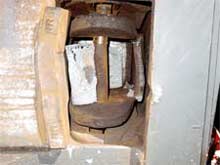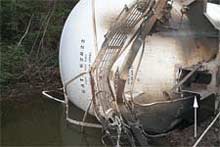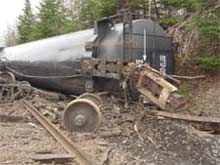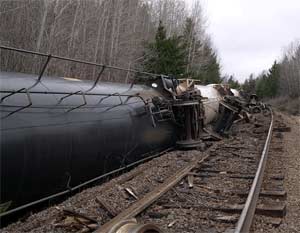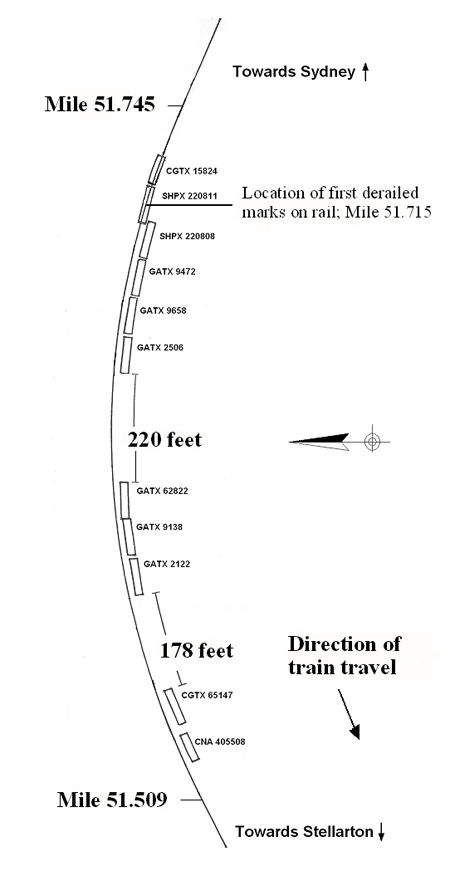Main-track derailment
Cape Breton and Central Nova Scotia Railway
Train No. CBNS 301-18
Mile 51.7, Hopewell Subdivision
Linacy, Nova Scotia
The Transportation Safety Board of Canada (TSB) investigated this occurrence for the purpose of advancing transportation safety. It is not the function of the Board to assign fault or determine civil or criminal liability. This report is not created for use in the context of legal, disciplinary or other proceedings. See Ownership and use of content. Masculine pronouns and position titles may be used to signify all genders to comply with the Canadian Transportation Accident Investigation and Safety Board Act (S.C. 1989, c. 3).
Summary
On 18 April 2004, at approximately 2335 Atlantic daylight time, Cape Breton and Central Nova Scotia Railway (CBNS) freight train 301-18, proceeding westward on the Hopewell Subdivision, derailed 10 cars at Mile 51.7 near Linacy, Nova Scotia. Nine of the ten derailed cars were pressure tank cars loaded with liquefied petroleum gas, UN 1075. There were no injuries, and there was no release of dangerous goods. Two schools and two homes in the vicinity were evacuated for nine days, while transhipping and flaring procedures were conducted on the derailed tank cars. CBNS, whose head office is located in Stellarton, Nova Scotia, is a provincially regulated railway. It is a subsidiary of RailAmerica Inc., which is a group of 47 railways with headquarters in Boca Raton, Florida, United States. The TSB investigated the derailment at the request of the provincial government.
Ce rapport est également disponible en français.
Factual information
Cape Breton and Central Nova Scotia Railway (CBNS) freight train 301-18 (the train) departed SydneyFootnote 1 en route to Truro (Figure 1). The train, powered by 4 locomotives, comprised 54 loaded cars and 10 empty cars. The train weighed approximately 6250 tons and was about 3800 feet long. The crew consisted of a conductor and a locomotive engineer, both of whom were positioned in the cab of the lead locomotive. They were qualified for their respective positions, met fitness and rest standards, and were familiar with the subdivision.
The weather was calm and clear with a temperature of 3°C.
The trip from Sydney was without incident until Mile 51.7, near Linacy in the county of Pictou. At 2335 Atlantic daylight time,Footnote 2 as the train was traversing a section of curved track in preparation to climb an ascending grade of 1.5 per cent, it experienced a train-initiated emergency brake application. The event recorder data indicated that recently the locomotive throttle had been gradually moved from the No. 6 to the No. 7 position, and that the train was travelling at 30 mph at the time of the emergency brake application. The event recorder data also showed that the locomotive stopped at 2335:33.
There was nothing unusual noted with train operations. The train crew followed the emergency procedures. The conductor inspected the rear of the train and determined that 10 cars, the 54th car to the 63rd car from the head end, had derailed in a left-hand curve in the direction of train travel. Nine of the ten derailed cars were pressure tank cars loaded with liquefied petroleum gas (LPG, Class 2.1, UN 1075). The other derailed car was a box car loaded with paper products. Eight of the LPG tank cars rolled either over onto their sides or upside down (Photos 1 and 2). Following company requirements, the crew immediately reported the accident to the CBNS Stellarton office and the rail traffic control office located in North Bay, Ontario. The rail traffic controller (RTC) notified a CBNS Operations Manager in Stellarton, the TSB in Gatineau, Quebec, and CanutecFootnote 3 in Ottawa, OntarioFootnote 4.
LPG, as transported in tank cars, is a flammable colourless (and odourless) liquefied gas (i.e. shipped under pressure) whose vapours are heavier than air. It is a highly dangerous fire hazard when exposed to a source of ignition, including static discharge. In gas and liquid forms, LPG is an irritant that can cause eye injury, frostbite, or respiratory problems. It is toxic to the central nervous system at high concentrations, and can also act as an asphyxiant. For unknown concentrations, protective clothing (such as eye, skin, and respiratory protection, e.g. self-contained breathing apparatus) is recommended until the area is deemed safe using specialized gas detection equipment.
There were no injuries nor release of dangerous goods. One car was lightly damaged, eight cars were heavily damaged, and one car was destroyed. Approximately 1100 feet of track was extensively damaged or destroyed.
The derailed cars were in three groups (see Appendix A). There were several fractured car parts among the third, fourth, and fifth derailed cars. These were:
- a fractured coupler cross key on the leading end (B-end) of the third car (GATX 2122, Photo 3);
- a broken coupler shank on the leading end (B-end) of the fourth car (GATX 9138, Photo 4); and
- a broken stub sill on the trailing end of the fifth car (GATX 62822, photos 5 and 6).
It was determined that the stub sill broke in the post-derailment sequence. The coupler cross key and the coupler shank were sent to the TSB Engineering Laboratory in Ottawa for further examination and analysis (see Appendix B). Both parts were subsequently determined to have failed in brittle overstress under torsional loads, consistent with failure as a result of the derailment. However, the mechanical properties of the material in the coupler shank were found to be outside of the Association of American Railroads (AAR) specifications, particularly as far as ductility was concerned. A TSB Engineering Laboratory report (LP 064/2004) concluded, in part, that:
- Charpy impact testing revealed the coupler material did not meet the minimum required level of energy absorption at -40°F (8.33 foot-pounds versus 20 foot-pounds prescribed);
- Tensile testing revealed low elongation, slightly below the specified minimum for Grade E coupler material (12.7 per cent versus minimum 14 per cent prescribed); and
- gas porosity in the casting, considered as being AAR severity 3, served to locate the initiation site for the overstress failure.
Although the coupler shank failure was not considered to be a contributory factor in this accident, the observations were similar to a broken coupler involved in an occurrence on the Broadview Subdivision, Manitoba, in 2002. In both occurrences, the couplers did not meet all AAR specifications, and the quality assurance system employed by the manufacturers failed to identify this shortcoming.
Examination of the other derailed equipment revealed that one wheel of box car CNA 405508 was worn to the AAR wear limit of 15/16 inch (location R-2); however, it was within the limit allowed by the Transport Canada-approved Railway Freight Car Inspection and Safety Rules, and the physical damage to the remaining parts of the car suggested that it was not the first car derailed. There were no other mechanical defects that were considered to have contributed to the accident.
The Hopewell Subdivision extends from Truro, Mile 2.3, to Havre Boucher, Mile 116.2. It consists of a single main track. Train movements are controlled by the Occupancy Control System authorized by the Canadian Rail Operating Rules and supervised by the RTC in North Bay. The authorized zone speed between Mile 38.5 and Mile 66.0 was 35 mph for both passenger and freight trains. Between Mile 51.0 and Mile 52.6, the maximum authorized train speed was permanently restricted to 30 mph. The track was classified as Class 3 track according to the Railway Track Safety Rules (TSR).
In the derailment area, the track structure consisted of 115-pound continuous welded rail (CWR), manufactured and installed in 1981, on the high (north) rail, and jointed 115-pound rail, manufactured in 2002 and installed in 2003, on the low (south) rail.Footnote 5 Some of the jointed rail in the vicinity of the initial point of derailment was noted as having low spots due to ballast and subgrade settlement.
Ties were No. 1 hardwood (2960 per mile). Tie plates were mainly 11 inches, with some 14-inch tie plates on curves, with two spikes per tie plate on tangent track, and three spikes per tie plate (or more) on curves. The rail was box-anchored every second or third tie. Ballast was clean crushed gravel (1 ½-inch diameter). The most easterly marks on the rail from the derailed equipment were located approximately 225 feet west of the entry of the spiral.
The TSR require a minimum of 10 crossties, in good condition and effectively distributed, for each 39-foot segment of rail. There were 26 defective ties (split, spike-killed, or broken) out of 93 ties between the entry of the spiral and the point of derailment, which is within TSR allowable limits. Several locations had two defective ties in a row; others had up to four defective ties in a cluster (Photo 7).
The track was tested annually for rail flaws and geometry defects. An ultrasonic inspection of the rail was performed on 18 August 2003. The track was last inspected by a track maintenance employee in a hi-rail vehicle on 14 April 2004. At that time, no exceptions in the derailment area were noted. A track geometry test was last performed 23 July 2003 using contractor hi-rail equipment that applied 15 000 pounds of vertical load and 9000 pounds of lateral load to the track structure to obtain loaded gauge readings. The test recorded 406 feet of red and yellow wide gauge in the 1246-foot curve between Mile 51.745 and Mile 51.509. (Red wide gauge is defined as 1 ½ inches wide, and yellow is ¾ inch wide.) The maximum gauge deviation permitted for Class 3 track by the TSR was 1 ¼ inches. Subsequent repairs were performed by local track maintenance employees who attended to the urgent defect areas by re-gauging the track and then securing the rail with additional spikes. Post-accident track measurements for cross-level and gauge for 20 stations (measured 15 feet 6 inches apart) east of the point of derailment are shown in Appendix C.
Transport Canada personnel inspected the Hopewell Subdivision annually. A review of the inspection records for years 2000 through 2004 did not indicate any exception in the derailment area.
Track conditions
On 05 May 2004, TSB and CBNS personnel examined track between Mile 43.28 and Mile 79.77 of the Hopewell Subdivision during a hi-rail inspection. General observations on the track conditions noted were as follows:
- The rail was primarily 115-pound CWR in generally good condition. There were 16 miles of bolted 100-pound rail on the territory (12 miles of which were west of Stellarton). Rail movement between one-half inch and one inch was noted in some areas.
- There were many curves on the territory. The curve at the derailment location was a compound three- to four-degree curve, with five inches or more superelevation at some points through the body of the curve. The superelevation corresponded to a balance speed (the speed at which the weight of a car would be equally distributed on both rails and no lateral force) of 45 mph. This superelevation was suitable for trains that were travelling over the subdivision at higher speed prior to 1993. The speed has since been reduced to 30 mph; however, the superelevation remained generally unchanged. With train operations at 15 mph less than the balance speed, the low rail was subjected to increased lateral forces.
- The likelihood of derailment is related to the ratio of lateral to vertical force (L/V) acting on the head of the rail. When a car is going around a curve at underbalanced speed, the low rail vertical force is larger than the vertical force applied on the high rail and the wheel flanges contact the low rail gauge face, resulting in large gauge spreading forces at the low rail. Wheels rolling on the high rail tend to have a lower vertical force and, therefore, a higher L/V ratio, making wheel climb or lift more likely. Entry spirals are the point where a car's outer lead wheel of the lead truck forces the truck to swivel, increasing the lateral forces on the rail and that wheel's L/V ratio. The point at which track destruction started was in the entry spiral of the curve; this is an area where tank cars, due to their rigid construction, are prone to derail in the presence of any track irregularities. Although excessive wheel wear can contribute to an increase in lateral rail force, the R-2 wheel on box car CNA 405508 was the only wheel determined to have any significant wear, and, as mentioned, it was within allowable safety limits. It was also located on the north, or high, rail of the curve. Given the excess superelevation in this curve and the relatively low train speed, it is unlikely that either the wheel wear or the gradual increase in locomotive throttle position (i.e., from the No. 6 to the No. 7 position) contributed significantly to any increase in the L/V ratio.
- In locations where clusters of bad ties exist, the ability of the track structure to restrain the gauge spreading forces exerted on it is greatly reduced. Rail fasteners need to have high stiffness in order to reduce the lateral rail deflections under load to reduce rail spreading. As there was a history of wide gauge through a third of the curve, the derailment could have occurred anywhere in a cluster of bad ties.
- During the hi-rail inspection, some clusters of defective ties were observed, with an average of 25 per cent defective across the territory examined. At one location, at the east end of the Sutherlands River bridge, six defective ties in a row were noted.
CBNS site assessment
The train crew's preliminary assessment was that the derailed cars included all the loaded LPG cars at the end of their train. The train crew regularly handled such cars and were familiar with their potentially explosive properties. They also had the shipping documents that contained the emergency response information. During their initial assessment, the train crew could see no fire, nor could they hear any escaping gases. To provide a more accurate assessment of the extent of the damage and the potential risks, they walked to the end of the derailed cars, relying partially on their sense of smell to determine if any of the cars were leaking. At that time, they were unaware that three of the LPG cars, which were loaded with butane, were non-odourized, that is no mercaptanFootnote 6 had been added. Therefore, they would not have been able to detect a leaking butane gas car by smell.
911 system
As the RTC office was located in Ontario, local railway officials contacted the area Royal Canadian Mounted Police (RCMP). They called a non-emergency number (not 911). The accident information was received by the Truro RCMP detachment, approximately 70 km away, but not on the 911 system. The 911 system is designed to facilitate emergency response by providing emergency contact information for various types of emergencies to individuals who are coordinating emergency response efforts in their initial stages. The information can be sent electronically to specially equipped police cars for rapid use in the field. Helpful and accurate messages can be relayed back and forth, and historical records of communications can be archived for later scrutiny, if required. Emergency response information, such as contact numbers for police, fire, medical, environment, poison control, Canutec, and emergency measures organizations, are readily obtained and shared.
In the event of an emergency, an RTC is often the single most important contact point for calling out other agencies such as the TSB, Canutec, and the Railway Association of Canada. There are a number of shortlines under provincial jurisdiction in Canada that locate their RTCs in another province. As highlighted in this occurrence, although the RTC offices can access individual phone numbers for police, fire, and medical services, in some cases the RTC does not have direct access to the 911 system or coordinator in the province in which the shortline is operating.
In the early hours of the occurrence, the railway was unaware that the accident was located in the Linacy Fire Department's jurisdiction, and so relied on the larger New Glasgow Fire Department for a gas detection device to test for the presence of explosive gases in the air. The Linacy Fire Chief was not aware of the unfolding emergency within the Linacy area (including two school closures and a minor evacuation) until notified by the Emergency Measures Coordinator around 0700 the next day (some seven hours after the accident). Because the 911 system was not used, the many coordinating benefits of the system, and the communication of accurate and timely information to all required emergency response agencies, was not realized.
Also, the RCMP report of the railway's initial phone call indicated that the exact location of the derailment was not known. However, railway personnel were well aware of the accident location through their standard identifiers, namely, subdivision and mileage. During subsequent discussions, it was revealed that the 911 system was not readily able to facilitate the dispatch of emergency response personnel to railway accidents using subdivision and mileage identifiers. However, the 911 system can respond quickly to other transportation accidents. For example, in pipeline accidents involving Maritimes and Northeast Pipeline, the infrastructure is identified using kilometre posts along the entire length of the right-of-way, and all access points to such distance markers are readily identified on office maps. Similarly, 100-series Nova Scotia highways have recently been identified with kilometre posts that facilitate dispatching emergency responders to emergency sites. At present, no such capability exists for railway accidents reported to the 911 office. There are five railways that regularly operate in Nova Scotia (Canadian National, VIA Rail Canada Inc.,Footnote 7 Windsor and Hantsport Railway, Sydney Coal Railway, and CBNS). Better coordination between the municipalities and the railways would facilitate a more timely emergency response. Such coordination could include identifying all currently available access points to subdivision names and mileage posts, and correlating these with other important topographical information in the 911 office, such as water courses, power and gas lines, bridges, culverts, and schools.
Emergency response
Response personnel included the RCMP, the New Glasgow and Linacy fire departments, the Bible Hill Special Hazards Response Unit, the LPG Emergency Response Team (from RST Industries, Saint John), and CBNS railway officials. The Emergency Response Guidebook suggested an initial isolation zone of 800 metres. As this zone extended beyond railway property, and required evacuating two schools and two homes, the localFootnote 8 regional Emergency Measures Organization response plan was implemented, and the Assistant Fire Chief of the Linacy Fire Department was subsequently appointed overall Incident Commander.
Other responding agencies included the Railway Association of Canada, Transport Canada Dangerous Goods, Canutec, Environment Canada, the provincial Department of Environment and Labour, and other municipal, provincial, and federal representatives. Regular multi-agency briefings were conducted and the overall emergency response, which lasted for over one week, was well coordinated and carefully executed.
Post-accident, a multi-agency debrief was conducted 10 June 2004 in Westville by the Nova Scotia Emergency Measures Organization. The emergency response efforts of all responding agencies were reviewed to identify opportunities for further improvement of emergency response plans.
Findings
Finding as to causes and contributing factors
- The train derailed as a result of a combination of track conditions (excessive superelevation, wide gauge, and defective ties) when rigid pressure tank cars, which are prone to derailment in areas of track irregularities, were negotiating an entry spiral of a three- to four-degree compound curve at underbalanced speed.
Findings as to risk
- As the three butane cars were non-odourized (that is, no mercaptan had been added to the butane) and as liquefied petroleum gas (LPG) is odourless, the train crew placed themselves at risk by attempting to inspect the derailed LPG cars relying on their sense of smell, rather than using gas leak detection devices.
- The 911 system was not used by the railway to report the accident; therefore, the capability of the 911 system to facilitate the emergency response effort and communicate accurate and timely emergency response information among all first responders (including police, fire, medical, railway, shipper, municipal, provincial, and federal agencies) was not realized.
- Although all railway subdivisions are marked with mile posts, and by using them the railway knew the exact location of the train derailment, the 911 office was not able to quickly identify the railway location because they were not set up to facilitate the dispatch of emergency response personnel to such identifiers.
- Although the fractured coupler shank from tank car GATX 9138 was not considered causal to this derailment, both TSB testing and external testing revealed that it had very low energy-absorbing capability, meaning that in severe cold weather it could pose a risk to safe train operations, particularly those involving dangerous goods.
Safety action
Track conditions
Cape Breton and Central Nova Scotia Railway (CBNS) has put a program in place to identify and prioritize areas where excess superelevation conditions exist. This program covers maintenance, tie installation, and curve elevation reductions. Fifty-seven curves with excess elevation were identified on the Hopewell Subdivision. Fifty-one have already been repaired, and the balance will be corrected in the 2005 Tie and Surfacing Program.
In 2004, CBNS also completed the following work on the Hopewell Subdivision:
- approximately 21.4 miles of surfacing was performed;
- over 21 000 feet of gauging was performed; and
- 10 234 ties, as well as additional spikes, were installed.
CBNS has been working at eliminating the 100-pound rail by scrapping the low rail, transposing the high rail to the low side, and installing new 115-pound rail on the high side. To correct areas where there was ballast settlement (e.g., rail joint locations), a tamping machine was incorporated into the rail installation program to ensure loose and hanging ties were installed tight to the rail.
Coupler castings
In September 2004, the TSB issued a Rail Safety Information Letter (10/04), Mechanical Properties of Coupler Casting. This letter, which was sent to the Nova Scotia Department of Transportation and Public Works, and copied to Transport Canada (TC) and the Railway Association of Canada, highlighted the condition of the coupler casting that was broken on the fourth derailed car (GATX 9138). Subsequently, TC brought the matter to the attention of the Association of American Railroads (AAR) emphasizing how the quality assurance processes in place by the manufacturer failed to identify the shortcomings found by the TSB Engineering Laboratory. The AAR has also been requested to provide information on any follow-up corrective action that it may take as a result of this derailment.
911 system
The Emergency Measures Organization (EMO) for Nova Scotia has had an initial meeting with CBNS to address the current status of the 911 system. The EMO plans to meet with all railways operating in Nova Scotia to improve the 911 system for rail-related emergencies.
This report concludes the Transportation Safety Board's investigation into this occurrence. Consequently, the Board authorized the release of this report on .
Appendices
Appendix A – Schematic identifying and showing the approximate position of derailed cars
Appendix B – List of Supporting Reports
The following TSB Engineering Laboratory reports were completed:
- LP 057/2004 - Analysis of Fractured Coupler Cross Key (from B-end of GATX 2122)
- LP 064/2004 - Analysis of Fractured Coupler Shank (from B-end of GATX 9138)
These reports are available from the Transportation Safety Board of Canada upon request.
Appendix C – Post-accident track measurements
| Station | Plus | Light Cross-Level | Loaded Cross-Level | Light Gauge | Loaded Gauge | Comments |
|---|---|---|---|---|---|---|
| 1 | - | ¾ | 5/8 | 56 ¾ | 56 ¾ | |
| 2 | - | ½ | 3/8 | 56 ½ | 56 ½ | |
| 3 | - | ¾ | 5/8 | 56 7/8 | 57 | |
| 4 | - | 1 1/8 | 1 ¼ | 56 7/8 | 57 | |
| 5 | - | 1 | 7/8 | 56 5/8 | 56 5/8 | |
| 6 | - | 1 ¼ | 1 1/8 | 56 ¾ | 56 ¾ | |
| 6 | 8' 3" | 1 ½ | 1 ½ | 56 ½ | 56 5/8 | |
| 7 | - | 1 ½ | 1 ½ | 56 ½ | 56 ½ | |
| 8 | - | 2 1/8 | 2 | 57 | 56 5/8 | Tangent to Spiral |
| 9 | - | 2 1/8 | 2 | 56 ½ | 56 5/8 | |
| 10 | - | 2 | 2 | 56 5/8 | 56 5/8 | |
| 11 | - | 2 3/8 | 2 ¼ | 56 7/8 | 56 5/8 | |
| 12 | - | 2 ½ | 2 ½ | 56 ¾ | 56 7/8 | |
| 13 | - | 2 ¾ | 2 5/8 | 56 7/8 | 57 | |
| 14 | - | 3 | 2 7/8 | 56 ¾ | 57 | |
| 15 | - | 3 ¾ | 3 ¼ | 57 | 57 ¼ | |
| 16 | - | 3 7/8 | 3 5/8 | 56 ½ | 56 ½ | |
| 17 | - | 4 | 3 ¾ | 56 ½ | 56 ½ | |
| 17 | 10' 0" | 3 ¾ | 4 1/8 | 56 ¾ | 56 7/8 | |
| 18 | - | 4 | 3 ¾ | 56 ¾ | 56 7/8 | |
| 19 | - | 4 ¼ | 3 5/8 | 57 | 56 7/8 | |
| 20 | - | 4 | - | 57 ½ | - | |
| 21 | - | 5 | - | 57 ½ | - |
Point of Derailment
